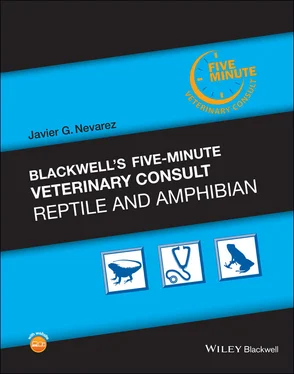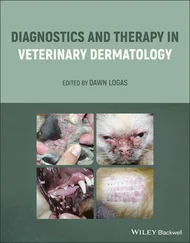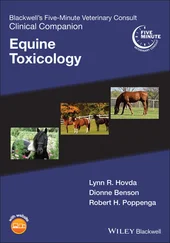DRUG(S) OF CHOICE
Trimethoprim sulfonamide 30 mg/kg PO SID for 14 days, then 1–3 times weekly for 3 months may reduce oocyst shedding but does not eliminate cryptosporidium organisms from the gastrointestinal mucosa.
Paromomycin 100 mg/kg PO SID for 7 days; then twice weekly for 6 weeks; and 360 mg/kg q48h for 10 days resulted in complete resolution in experimentally infected bearded dragons (Pogona vitticeps).
Hyperimmune bovine colostrum 1% body weight by volume PO once weekly for 6 weeks. Currently not available commercially.
Euthanasia should be strongly considered for affected animals to limit spread.
If euthanasia is not an option, diseased reptiles should be separated from the remaining collection and strict barrier nursing protocols enacted to prevent spread.
 FOLLOW‐UP
FOLLOW‐UP
Regular fecal examination and ELISA assays for suspected at risk animals.
Monitor for signs of disease, i.e., wasting, diarrhea, persistent regurgitation.
EXPECTED COURSE AND PROGNOSIS
Grave prognosis, likely chronic wasting and death.
 MISCELLANEOUS
MISCELLANEOUS
COMMENTS
N/A
C. pestis is a known zoonotic risk; C. ducismarci shows genetic similarities to other zoonotic Cryptosporidium spp.
Caution should be used when working with suspected cases.
N/A
ELISA = enzyme‐linked immunosorbent assay
IFA = immunofluorescent antibody
IM = intramuscular
IV = intravenous
PCR = polymerase chain reaction
PO = per os
SC = subcutaneous
1 Cranfield MR, Graczyk TK. Cryptosporidiosis. In: Mader DR, ed. Reptile Medicine and Surgery. 2nd ed. St. Louis, MO: Elsevier Saunders; 2006:756–762.
2 Fayer R. Taxonomy and species delimitation in Cryptosporidium. Exp Parasitol Jan 2010; 124(1): 90–‐97.
3 Fayer R, Graczyk TK, Cranfield MR. Multiple heterogenous isolates of Cryptosporidium serpentis from captive snakes are not transmissible to neonatal BALB/c mice (Mus musculus). J Parasitol 1995;81(3):482–484.
4 Graczyk TK, Owens R, Cranfield MR. Diagnosis of subclinical cryptosporidiosis in captive snakes based on stomach lavage and cloacal sampling. Vet Parasitol 1996;67:143–151.
5 Grosset C, Villeneuve A, Brieger A, Lair S. Cryptosporidiosis in juvenile bearded dragons (Pogona vitticeps) effects of treatment with paromomycin. J Herp Med Surg 2011;21:10–15.
6 Pedraza‐Diaz S, Ortega‐Mora LM, Carrion BA, et al. Molecular characterisation of Cryptosporidium isolates from pet reptiles. Vet Parasitol 2009;160(3–4):204–210.
7 Plutzer J, Karanis P. Genetic polymorphism in Cryptosporidium species: An update. Vet Parasitol 2009;165(3–4):187–199.
8 Richter B, Rasim R, Vrhovec MG, et al. Cryptosporidiosis outbreak in captive chelonians (Testudo hermanni) with identification of two Cryptosporidium genotypes. J Vet Diagn Invest 2012;24(3):591–595.
9 Scullion FT, Scullion MG. Gastrointestinal protozoal diseases in reptiles. J Exot Pet Med 2009;18(4):266–278.
10 Shahiduzzaman M, Daugschies A. Therapy and prevention of cryptosporidiosis in animals. Vet Parasitol 2012;188(3–4):203–214.
11 Traversa D. Evidence for a new species of Cryptosporidium infecting tortoises: Cryptosporidium ducismarci. Parasit Vectors 2010;3(21):1–4.
12 Traversa D, Iorio R, Otranto D, et al. Cryptosporidium from tortoises: Genetic characterisation, phylogeny and zoonotic implications. Mol Cell Probes 2008;22(2):122–128.
13 Uhl EW, Jacobson E, Bartick TE, et al. Aural‐pharyngeal polyps associated with Cryptosporidium infection in three iguanas (Iguana iguana). Vet Path 2001;38:239–242.
AuthorT. Franciscus Scheelings, BVSc, MVSc, PhD, MANCVSc (Wildlife Health) DECZM (Herpetology)
Diarrhea
 BASICS
BASICS
DEFINITION/OVERVIEW
Diarrhea is the production of unformed or liquid fecal matter. It is often associated with increased fecal volume and frequency of defection.
Diarrhea is usually associated with enteritis due to primary infectious (e.g., endoparasites) or non‐infectious (e.g., dietary) causes.
In tortoises with a natural diet high in dietary fiber (e.g., African and European tortoises) ingestion of diets high in fermentable carbohydrates (e.g., fruits) and/ or insufficient fiber ingestion can result in dysbacteriosis, which can result in diarrhea.
Environmental factors, such as low temperatures, lead to decreased gastrointestinal motility, dysbacteriosis and diarrhea due overgrowth of opportunistic pathogens.
Diarrhea is common in tortoises, but uncommon in freshwater turtles, which normally have unformed liquid feces.
Most commonly kept tortoise species require a high‐fiber, low sugar, and low protein diet, and therefore feeding large amounts of fresh fruits and starch containing vegetables will frequently lead to unformed feces or diarrhea.
The following endoparasites can be associated with diarrhea in tortoises:nematodes: oxyurids are very common in tortoises; ascarids are reported in wild‐ caught Testudo spp. (European tortoises) in captivity; other nematodes such as Strongyloides and Capillaria are uncommoncoccidia: uncommonciliated protozoa: Nyctotherus spp., Balantidium spp., Entamoeba spp. (E. invadens)flagellates: Trichomonas spp.
Bacteria: Proteus and Salmonella spp. are often asymptomatic carriers, but can lead to diarrhea.
Diarrhea is more common in tortoises than in turtles.
Inappropriate husbandry: low environmental temperatures and overcrowding (stress) can lead to enteritis and diarrhea.
Inappropriate diet: tortoises fed a low‐fiber diet, high in fermentable sugars and protein, are prone to develop diarrhea.
Owners report liquid feces, frequently malodorous, with increased frequency of defecation.
Straining to defecate, anorexia, and cloacal prolapse may also be reported.
Depending on duration (acute vs. chronic), severity and etiology of diarrhea.
Fecal staining around cloaca, and ventral aspects of proximal hind limbs and tail base.
Presence of abnormally soft or liquid fecal matter in transport container.
Tortoises with diarrhea caused by an inappropriate diet might show no other clinical signs or may show unspecific clinical signs, such as lethargy, reduced food intake, or dehydration.
Chronic diarrhea can lead to weight loss and cachexia due to malabsorption of nutrients.
Cloacal tissue prolapse, such as rectal/distal colon prolapse, or true cloacal prolapse.
In most tortoises (except red‐ and yellow‐ footed tortoises)—diet low in fiber and/or high in fermentable simple carbohydrates (e.g., fruits).
Читать дальше

 FOLLOW‐UP
FOLLOW‐UP MISCELLANEOUS
MISCELLANEOUS BASICS
BASICS










